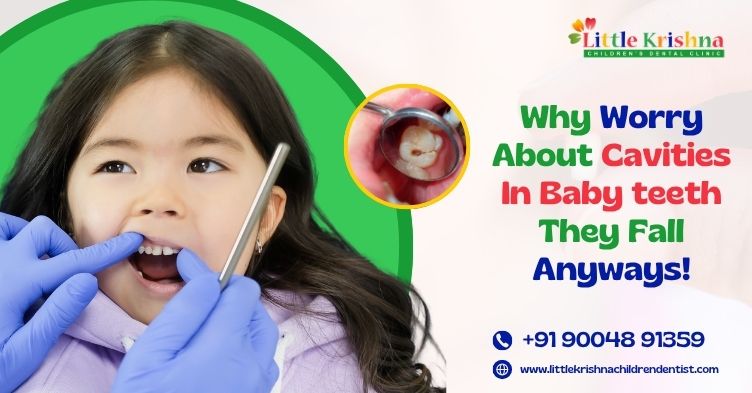Why Worry About Cavities In Baby Teeth- They Fall Anyways!
How significant is it for a baby or toddler to have cavities? Since baby teeth eventually fall out, is treatment really necessary for them?
Cavities in baby teeth are a considerable issue as early childhood caries spreads more quickly than tooth decay in adult teeth.
Know what problems they can face and why cavity filling is crucial for kids. If you are looking for a kids dentist in Mumbai, visit Little Krishna Children's Dental Care to get cavity filling for kids
Symptoms of untreated Early Childhood Caries
1. Pain:
Early childhood caries starts in the upper layer of the tooth, known as enamel, and can advance toward the center. Once a cavity penetrates the enamel, it exposes the second layer of the tooth, called dentin, which can result in tooth sensitivity and pain. The enamel on primary teeth is thinner than permanent teeth, so cavities in baby teeth can become painful more quickly.
2. Premature tooth loss:
Early childhood caries is an aggressive type of tooth decay that destroys a child's teeth over a relatively short time. More frequently than you might expect, we see toddlers and preschoolers with cavities that have damaged their teeth so badly because of negligence.
Removal of a baby tooth may be necessary in early childhood caries when the child's cavity has reached the dental pulp, resulting in a severe infection.
Losing a milk tooth too early can lead to long-term dental issues like crooked teeth and bite problems. Since premature loss prevents the placement of prosthetic teeth, toddlers may go for years without those teeth until their permanent ones develop. This develops problems in functions such as eating, speaking, and aesthetic concerns.
3. Serious infections:
As discussed earlier, cavities can cause severe and painful infections of a child's dental pulp. If untreated, these infections may spread to other parts of the child's body.
How Is Cavity Filling Done for Kids?
Treating cavities in children is essential to ensure their overall health, proper oral development, and comfort. Here's how the process generally works:
- Diagnosis:
A pediatric dentist will first examine the child's teeth visually and may take X-rays to assess the extent of decay. - Treatment Plan:
If the cavity is caught early, a simple filling can restore the tooth. If the decay is more advanced, additional treatments like pulp therapy (similar to a mini root canal) may be necessary before the filling. - Filling Procedure:
The dentist will numb the area ( If the decay is more advanced to make the child comfortable.)
The decayed part of the tooth is removed carefully.
A biocompatible filling material, usually tooth-colored composite resin, is placed to rebuild the tooth’s structure.
Finally, the filling is shaped and polished to match the natural tooth.
Modern pediatric dentistry focuses mainly on ensuring the child's comfort during the entire procedure with child-friendly techniques and gentle care.
Why Cavity Filling Is Important in Kids?
Even though baby teeth are temporary, they play a critical role in guiding the proper eruption of permanent teeth. Untreated cavities can cause pain, infections, and long-term orthodontic issues. Filling cavities early preserves the tooth, maintains oral function, and protects your child’s beautiful smile.
Don't wait for cavities to turn into serious problems. Protect your child's oral health early by consulting an experienced kids dentist in Mumbai, at Little Krishna Children's Dental Care for cavity filling in kids. Our caring and skilled team ensures a comfortable, positive experience for your little ones, helping them maintain strong, healthy teeth for life.

